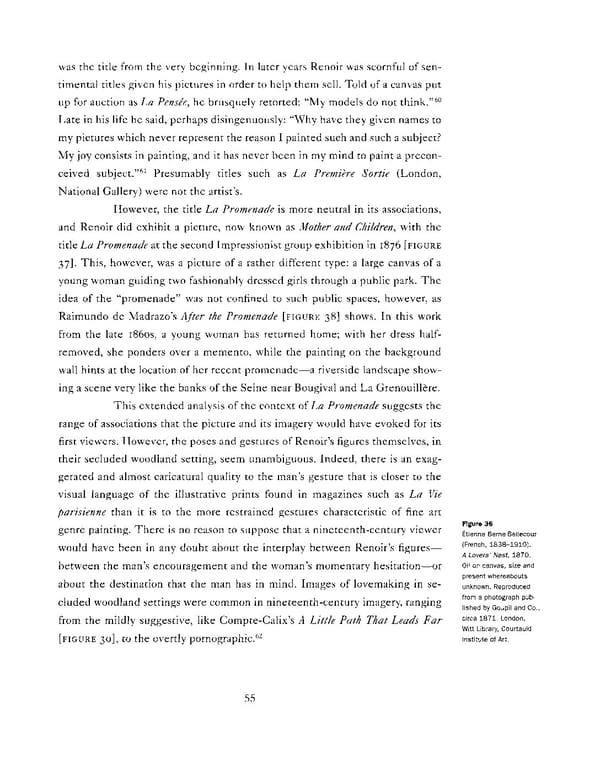was the title from the very beginning. In later years Renoir was scornful of sen- timental titles given his pictures in order to help them sell. Told of a canvas put up for auction as La Pensee, he brusquely retorted: "My models do not think."60 Late in his life he said, perhaps disingenuously: "Why have they given names to my pictures which never represent the reason I painted such and such a subject? My joy consists in painting, and it has never been in my mind to paint a precon- 61 ceived subject." Presumably titles such as La Premiere Sortie (London, National Gallery) were not the artist's. However, the title La Promenade is more neutral in its associations, and Renoir did exhibit a picture, now known as Mother and Children, with the title La Promenade at the second Impressionist group exhibition in 1876 [FIGURE 37]. This, however, was a picture of a rather different type: a large canvas of a young woman guiding two fashionably dressed girls through a public park. The idea of the "promenade" was not confined to such public spaces, however, as Raimundo de Madrazo's After the Promenade [FIGURE 38] shows. In this work from the late i86os, a young woman has returned home; with her dress half- removed, she ponders over a memento, while the painting on the background wall hints at the location of her recent promenade—a riverside landscape show- ing a scene very like the banks of the Seine near Bougival and La Grenouillere. This extended analysis of the context of La Promenade suggests the range of associations that the picture and its imagery would have evoked for its first viewers. However, the poses and gestures of Renoir's figures themselves, in their secluded woodland setting, seem unambiguous. Indeed, there is an exag- gerated and almost caricatural quality to the man's gesture that is closer to the visual language of the illustrative prints found in magazines such as La Vie parisienne than it is to the more restrained gestures characteristic of fine art genre painting. There is no reason to suppose that a nineteenth-century viewer Figure 36 Etienne Berne-Bellecour would have been in any doubt about the interplay between Renoir's figures— (French, 1838-1910). A Lovers' Nest, 1870. between the man's encouragement and the woman's momentary hesitation—or Oil on canvas, size and about the destination that the man has in mind. Images of lovemaking in se- present whereabouts unknown. Reproduced cluded woodland settings were common in nineteenth-century imagery, ranging from a photograph pub- lished by Goupil and Co., from the mildly suggestive, like Compte-Calix's A Little Path That Leads Far circa 1871. London, 62 Witt Library, Courtauld [FIGURE 30], to the overtly pornographic. Institute of Art. 55
 Pierre-Auguste Renoir: La Promenade Page 62 Page 64
Pierre-Auguste Renoir: La Promenade Page 62 Page 64